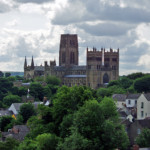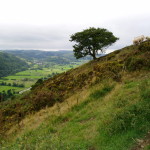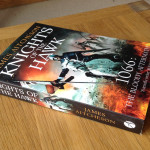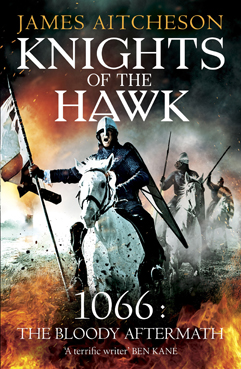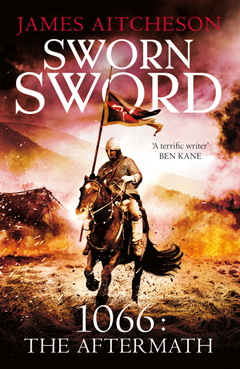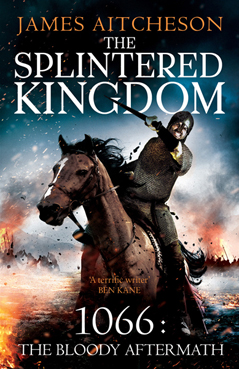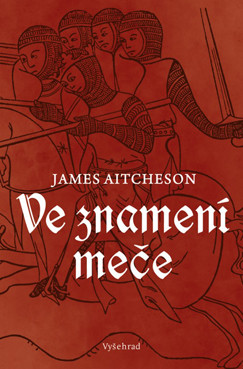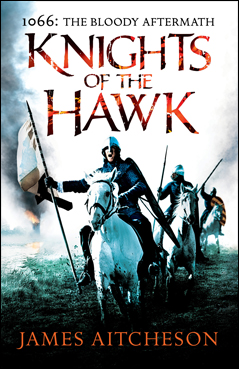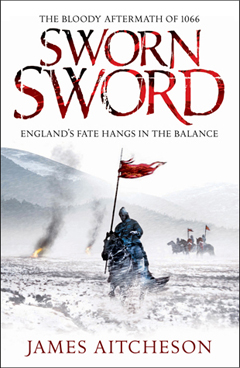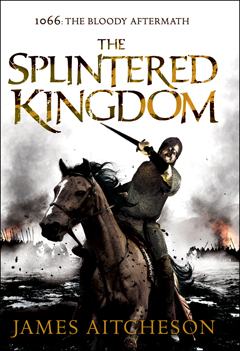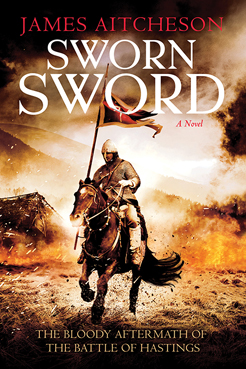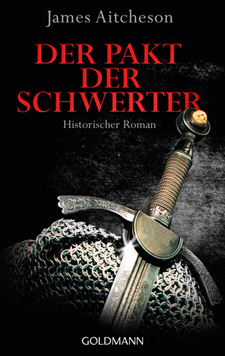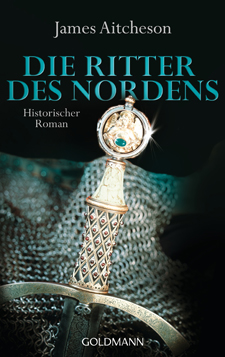Hot on the heels of last week’s addition to Tancred’s England, my historical guide to the kingdom as it was c.1066, I present to you another potted history for your delectation, this time focussing on the city of Durham.
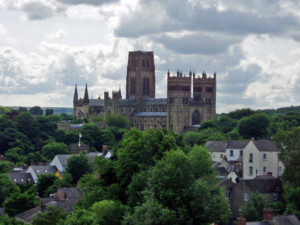
Durham Cathedral, standing on the promontory above the River Wear. Construction of the Norman cathedral began in 1093 and was largely complete by the 1130s.
As you’ll be able to see by following the links above, the article on Durham is now one of five exploring some of the key places featured in the Conquest Series. In time I’m hoping to expand Tancred’s England to include not just location entries but also features on other aspects of the world in which the novels are set, and articles on various historical topics connected with 1066, the Normans and Anglo-Saxon England. Feel free to get in touch if you have any ideas that you’d like to share!
Earlier this year I launched a new feature on this website to offer you, my readers, an extra insight into the world of the Conquest Series. Entitled Tancred’s England, the idea is to share with you some of the research that goes into writing the novels, by exploring the history of some of the key locations visited by Tancred in the course of his saga.
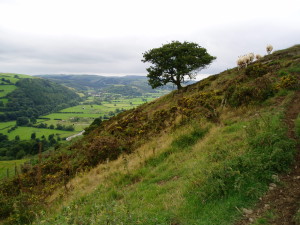
View over River Teme valley, from Offa’s Dyke Path, north of Knighton.
It’s a part of Britain that’s particularly rich in history, much of which can be freely accessed today. Ancient hill-forts, ruined castles and abbeys all abound, while for 64 miles the great Anglo-Saxon earthwork known as Offa’s Dyke cuts across this striking landscape. Named after the eighth-century Mercian king who is traditionally thought to have ordered its construction, the Dyke delineated the default boundary between England and Wales throughout much of the Middle Ages, and even after 1,200 years it remains a powerful symbol of Offa’s authority.

The cover for the US edition of
The Splintered Kingdom, due to be published by Sourcebooks Landmark
on August 5th, 2014.
I’ll be adding more entries in due course. One of those in the pipeline is about the city of Durham, where Tancred’s tale begins on that cold winter’s night in January 1069. As always, if you have any suggestions for places I could feature in future, please don’t hesitate to get in touch via the contact form.
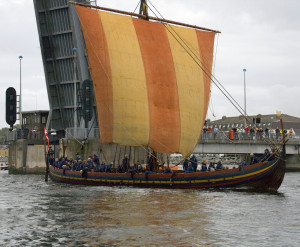
The reconstructed Viking ship, Sea Stallion, the subject of Tom Birkett’s paper at the Unlocking the Vikings conference, sails into Dublin, 14 August 2007.
(Image adapted under the Creative Commons Attribution-ShareAlike 2.0 Generic licence from an original photo by William Murphy.)
2014 is turning out to be the year of the Norsemen! As well as visiting the Vikings: Life and Legend exhibition at the British Museum and attending the Midlands Viking Symposium in the spring, last weekend I took time out from working on my latest novel-in-progress to go to the Unlocking the Vikings conference at the University of Nottingham.
In common with last year’s The Middle Ages in the Modern World at the University of St Andrews, the focus of the two-day event was as much upon the various ways in which the Viking Age has been represented in modern culture as it was upon the history itself. There were so many excellent papers and presentations – too many to mention individually – but I’ve chosen some of what, for me, were the highlights of the weekend.
The first session of the conference focussed on the Vikings in fiction, something of great interest to me since the Norsemen feature prominently both in Tancred’s saga and in the wider story of the Norman Conquest. Historian and novelist VM Whitworth (University of the Highlands and Islands) spoke about developing Viking Age characters, and the need for authors to fully immerse themselves in the thought-world of their creations. Ruarigh Dale (University of Nottingham) discussed portrayals of berserkers in current fiction, and how modern concepts compare with the original descriptions of these warriors in the Norse sagas.
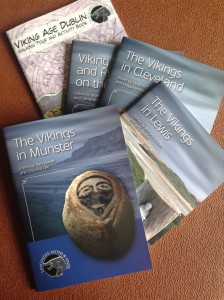
The findings of the Languages, Myths and Finds project were brought together in these five beautifully produced booklets.
The conference also marked the conclusion of the Languages, Myths and Finds project, which aimed to investigate how Norse heritage and culture continue to make an impact in the twenty-first century, and the ways in which the Viking past is remembered and celebrated in Dublin, Munster, the Isle of Man, the Hebrides and Cleveland. Each of the regional teams presented their findings, which included the dramatic reveal by the Cleveland researchers of a previously unknown Viking runestone – an especially exciting discovery since, in contrast to Scandinavia, so few have been found in England.
As well as giving presentations at the conference, the teams also produced a series of booklets containing the findings of their research (pictured, above left): one for each of the five regions explored in the study. The booklets can also be downloaded in PDF form from the Languages, Myths and Finds website, where you can also find out more about the project and its aims. The video below from the University of Nottingham also gives a brief introduction.
Other highlights from the conference included a skaldic performance by Thor Ewing, featuring music on reconstructed Viking Age harp and flute, and a paper by Tom Birkett (University College Cork) on his experiences aboard the Sea Stallion – a reconstructed Viking ship based on the remains of Skuldelev 2, an eleventh-century vessel excavated at Roskilde, Denmark in 1962.
As always with these events, I came away brimming with ideas and armed with several pages of notes, furiously scribbled during the various talks and presentations. And who knows? Somewhere in all those notes might lie the inspiration for a future novel or two…
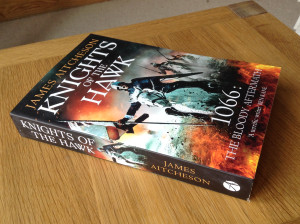
Knights of the Hawk • James Aitcheson • £6.99 • Arrow
Many thanks to everyone who entered my recent giveaway on Twitter to celebrate the publication in paperback this week of the latest instalment in Tancred’s saga, Knights of the Hawk.
Three lucky winners of the prize draw were selected using a random number generator. Each will each receive a signed copy of the book in paperback. And so without further ado, here they are:
Sarah Foran – @sarahforan1
Chi Dire – @diireh
Yasmin Lucy Greener – @YasminGreener
Congratulations to the winners – I’ll be contacting you directly on Twitter. If you didn’t win, better luck next time! You can find Knights of the Hawk on sale now, available from all good high street bookshops, as well as in Tesco and online.

The prize on offer to three lucky winners…
The rules are simple! The competition will run on Twitter, where you can already find me tweeting about 1066 and all things relating to the Middle Ages (@JamesAitcheson)
All you have to do to enter the prize draw and be in with a chance of winning is to RT one of my competition tweets. You’ll be able to tell which ones they are, because they’ll include the hashtag #giveaway.
Entries are limited to one per person and, due to the cost of postage, to those living in the UK. The competition will close at 11.59pm BST on Saturday 24th May. At that point I’ll put the names of all the entrants into a hat and randomly pick out three winners.
I’ll post the results of the competition both on Twitter and here on my blog, and will contact the winners via direct message (DM) so that they can send me their addresses.
Good luck, and happy tweeting!
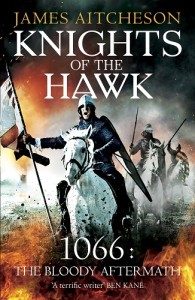
Knights of the Hawk • James Aitcheson
Arrow • Paperback • £6.99
A year on from the end of The Splintered Kingdom, Tancred is more driven and ambitious than ever. In this, the third instalment in his saga, he casts off some of the shackles binding him and strikes out on his own. Opening during the siege of Ely, where the infamous English outlaw Hereward the Wake has gathered a band of rebels to make one final, last-ditch stand against the Normans, Knights sees Tancred journeying overseas for the first time in the series.
Together with a host of unlikely allies, he sets out on a journey that will take him from the marshes of East Anglia into the wild, storm-tossed seas of the north, as he ventures in pursuit of love, of honour, and of vengeance. Just as in the previous two novels, battles and betrayals abound, but this time it’s personal.
Knights of the Hawk is available from all good high street bookshops and online, and also as an ebook for all major formats of readers. To celebrate the paperback release, I have a number of events lined up, with more being added to the calendar all the time, so keep checking back to see if I’ll be making an appearance in your area soon.
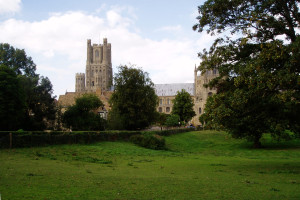
Ely, where Hereward the Wake and his allies made their
stand against the Normans in 1071, and where
Knights of the Hawk begins.
You can also find an entry on Ely and the Fens in my new website feature, Tancred’s England, if you’re interested in finding out more about the setting for Tancred’s latest adventure. As a special web-only bonus, I’ve included a map of how the area would have looked in the Middle Ages before the marshes were drained. There wasn’t space to include it in the book, but I think helps to illustrate the difficult nature of the terrain facing the Normans as they laid siege to Hereward’s island stronghold.

